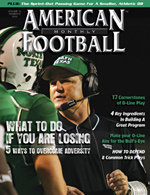Article CategoriesAFM Magazine
|
17 Cornerstones of Defensive Line Playby: Steve GrimitDefensive Line Coach, St. Cloud State University © More from this issue St. Cloud State University has a long tradition of excellence on the defensive line. In 2008, both defensive ends earned All-American honors, marking the third such honor in the past four seasons. Two of these players were named most valuable defensive lineman in the conference. Talented players are obviously the most important ingredient in our success. Utilizing an attacking and aggressive system of play has allowed these great players to play fast. Playing fast is a must in a position that does not allow time to think about your next movement. The cornerstones of defensive line play need to become second nature, creating a confident and aggressive player. · Explosive stance. Having sixty percent of the weight forward allows players to attack first. A toe to instep stagger is ideal if comfortable. If the stag....The full article can only be seen by subscribers.
|
|
|||||||
| HOME |
MAGAZINE |
SUBSCRIBE | ONLINE COLUMNISTS | COACHING VIDEOS |
Copyright 2025, AmericanFootballMonthly.com
All Rights Reserved





